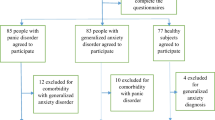Abstract
Levenson's (1973) locus of control scale was used to assess perceptions of control in individuals with panic disorder and social phobia, compared to a nonclinical sample. Both anxiety disorder groups showed a lower sense of internal control compared to the normal sample. Furthermore, the two anxiety disorder groups showed contrasting externality orientations. Panic-disordered individuals viewed events as proceeding in a random and uncontrollable way, while social phobics viewed events as controlled by powerful others. Partial correlations confirmed the unique relationship between each disorder and a particular externality orientation and indicated that low internal perceptions of control were strongly influenced by the presence of beliefs in chance and powerful others. These data suggest that perceptions of diminished control may be an affective—cognitive theme of anxiety, and that specific types of control perceptions are uniquely associated with these particular anxiety disorders.
Similar content being viewed by others
References
Abramson, L. Y., Seligman, M. E. P., & Teasdale, J. D. (1978). Learned helplessness in humans: Critique and reformulation.Journal of Abnormal Psychology, 87 49–74.
Adler, D., & Price, J. H. (1985). Relation of agoraphobics' health locus of control orientation to severity of agoraphobia.Psychological Reports, 56 619–625.
American Psychiatric Association (1987).Diagnostic and statistical manual of mental disorders (3rd ed., rev.). Washington, DC: Author.
Barlow, D. H. (1988).Anxiety and its disorders. New York: Guilford Press.
Barlow, D. H., & Cerny, G. A. (1988).Psychological treatment of panic. New York: Guilford Press.
Beck, A. T., & Emery, G. (1985).Anxiety disorders and phobias: A cognitive perspective. New York: Basic Books.
Betts, E. (1982). Relation of locus of control to aspiration level and to competitive anxiety.Psychological Reports, 51 71–76.
Clark, D. M. (1986). A cognitive approach to panic.Behaviour Research and Therapy, 25 443–455.
Cloitre, M., & Liebowitz, M. R. (1991). Memory bias in panic disorder: An investigation of the cognitive avoidance hypothesis.Cognitive Therapy and Research, 15 371–386.
Emmelkamp, P. M. G., & Cohen-Kettenis, P. T. (1975). Relationship of locus of control to phobic anxiety and depression.Psychological Reports, 36 390.
Fyer, A. J. (1991, March).Panic disorder in DSM-IV. Paper presented at the Panic Disorder Symposium: Current issues in diagnosis and treatment. New York: New York Academy of Medicine.
Heimberg, R. G. (1990). Cognitive behavior therapy for social phobia. In A. S. Bellack & M. Hersen (Eds.),Comparative handbook of treatment for adult disorders (pp. 203–218). New York: John Wiley and Sons.
Heimberg, R. G., Dodge, C. S., Hope, D. A., Kennedy, D. R., Zollo, L., & Becker, R. E. (1990). Cognitive behavioral group treatment of social phobia: Comparison to a credible placebo control.Cognitive Therapy and Research, 14 1–23.
Hibbert, G. (1984). Ideational components of anxiety: Their origin and content.British Journal of Psychiatry, 144 618–624.
Hope, D. A., Rapee, R. M., Heimberg, R. G., & Dombeck, M. (1990). Representations of self in social phobia: Vulnerability to social threat.Cognitive Therapy and Research, 14 177–189.
Houston, B. K. (1972). Control over stress, locus of control and response to stress.Journal of Personality and Social Psychology, 21 249–255.
Lazarus, R. S., & Averill, J. R. (1972). Emotion and cognition: With special reference to anxiety. In C. D. Spielberger (ed.),Anxiety: Current trends in theory and research. New York: Academic Press.
Levenson, H. (1973). Multidimensional locus of control in psychiatric patients.Journal of Consulting and Clinical Psychology, 41 397–401.
Levenson, H. (1981). Differentiating among internality, powerful others and chance. In H. M. Lefcourt (ed.),Research with the locus of control construct: Vol. 1. Assessment methods. New York: Academic Press.
Mandler, G. (1972). Helplessness: Theory and research in anxiety. In C. D. Spielberger (Ed.),Current trends in theory and research—III. New York: Academic Press.
Michelson, L., Mavissakalian, M., & Meminger, S. (1983). Prognostic utility of locus of control in treatment of agoraphobia. Behaviour Research and Therapy, 21, 309–313.
Mikawa, J. K., Nordin, K., & Eyman, J. (1986). The Self-Consciousness Scale and locus of control.Psychological Reports, 59 939–942.
Mineka, S., & Kelly, K. A. (1989). The relationship between anxiety, lack of control and loss of control. In A. Steptoe and A. Appels (Eds.),Stress, personal control and worker health. Brussels: John Wiley and Sons.
Mowrer, D. H., & Vick, P. (1948). An experimental analogue of fear from a sense of helplessness.Journal of Abnormal and Social Psychology, 43 193–200.
Peterson, C., & Seligman, M. E. P. (1984). Causal explanations as a risk factor for depression: theory and evidence.Psychological Review, 3 347–374.
Ray, W. J., & Katahn, M. (1968). Relation of anxiety to locus of control.Psychological Reports, 23 1196.
Sanderson, W. C., Rapee, R. M., & Barlow, D. H. (1987, November).The phenomenon of panic across the DSM-III-revised anxiety disorders. Paper presented at the annual meeting of the Association for Advancement of Behavior Therapy, Boston.
Spitzer, R. L., Williams, J. B. W., Gibbon, M., & First, M. (1987).Structured clinical Interview for DSM-III-R. New York: Biometrics Research Department, New York State Psychiatric Institute.
Watson, D. (1967). Relationship between locus of control and anxiety.Journal of Personality and social Psychology, 6 91–92.
Watson, D., & Baumal, E. (1967). Effects of locus of control and expectation of future control upon performance.Journal of Personality and Social Psychology, 6 212–215.
Author information
Authors and Affiliations
Additional information
This research was supported by National Institute of Mental Health grants 44119 and 40121 awarded to the second and third authors, respectively. We would like to thank James Cancienne for his participation in the data analysis and Craig Holt for his helpful comments on earlier drafts of this manuscript.
Rights and permissions
About this article
Cite this article
Cloitre, M., Heimberg, R.G., Liebowitz, M.R. et al. Perceptions of control in panic disorder and social phobia. Cogn Ther Res 16, 569–577 (1992). https://doi.org/10.1007/BF01175142
Issue Date:
DOI: https://doi.org/10.1007/BF01175142




